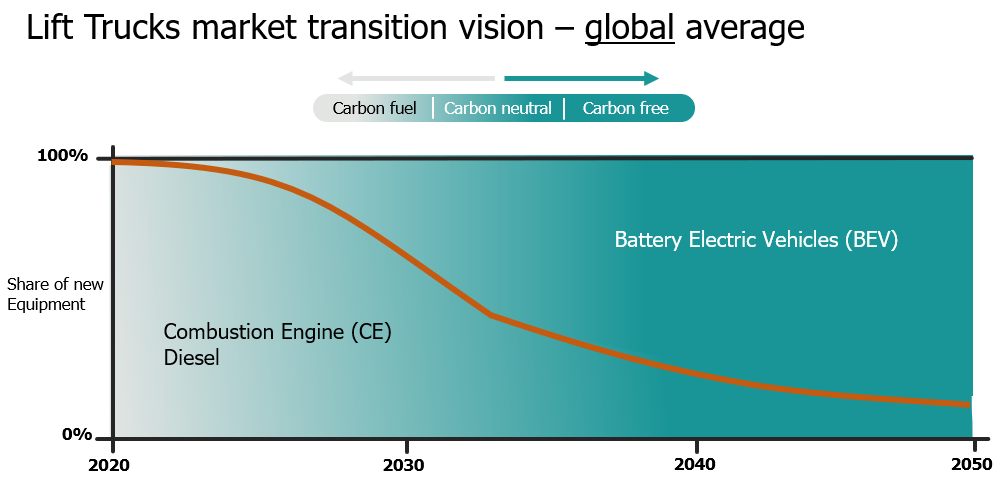Konecranes is committed to having fully electric variants of our entire product portfolio by 2026. We look at the path towards this goal and what our customers can already do to make lift truck operations more eco-efficient.
As a responsible corporate citizen, Konecranes is working hard towards a decarbonized and circular world. Under the Ecolifting™ umbrella, Konecranes enables customers to take systematic steps towards lower CO2 per container move.
Key to this is the wider use of electricity, both in our own operations and to power the lifting equipment we manufacture. But the move towards electrification is a journey, and we need to be realistic about the steps along the way.
When it comes to lift trucks – both from Konecranes and other manufacturers – diesel-powered internal combustion engines are the norm. Diesel technology is thus our starting point for transitioning lift trucks to electricity.
“It is expected that diesel-combustion engines will eventually give way to battery-powered electric vehicles as time progresses. Considering the widespread use of diesel technology and the steady pace of the transition, our immediate focus is on improving the eco-efficiency of diesel engines. Significant enhancements to Konecranes equipment already contributes to achieve this objective.” says Tobias Åkesson, Head of APAC for Lift Trucks at Konecranes.
Introduce biofuel. Optimize operations. Use more efficient drives.
 The first eco-efficient step that Konecranes lift truck operators can take is to change from using conventional fuel to biofuel. Hydrotreated vegetable oil (HVO 100) can be introduced without requiring any equipment modifications.
The first eco-efficient step that Konecranes lift truck operators can take is to change from using conventional fuel to biofuel. Hydrotreated vegetable oil (HVO 100) can be introduced without requiring any equipment modifications.
“By simply introducing HVO 100, operators can reduce equipment emissions by up to 90%. This fuel can be used in all Konecranes latest generation lift trucks. We have also been using it in our own factories for some years now,” explains Åkesson.
 The next step is to look at ways in which daily lift truck operations can be optimized. Significant fuel savings can be achieved by adjusting yard layouts, modifying driver behaviour and implementing eco-efficient practices such as reducing speed in certain areas. Konecranes TRUCONNECT telematic solution has been designed to support operators in performing these optimizations.
The next step is to look at ways in which daily lift truck operations can be optimized. Significant fuel savings can be achieved by adjusting yard layouts, modifying driver behaviour and implementing eco-efficient practices such as reducing speed in certain areas. Konecranes TRUCONNECT telematic solution has been designed to support operators in performing these optimizations.
“Thanks to this technology, operators, maintenance personnel, and service and terminal managers have access to a lot of useful remote-monitoring information that can help to make yard operations more efficient. This data also helps to increase safety and optimize performance and overall productivity. In addition, we offer a range of upgrades and retrofits that improve the eco-efficiency of Konecranes equipment,” says Åkesson.
Konecranes customers can also consider the Power Drive system for fuel efficiency. It’s a solution that improves transmission efficiency at high travelling speeds, and can therefore reduce engine RPM without compromising on performance. Power Drive reduces fuel consumption by between 15% and 25%. The investment is small and typically pays itself off within a year.
Flow Drive takes efficiency even further, allowing the engine to be downsized without compromising on performance. Fuel savings can be as high as 25%.
Whether customers opt for the Power Drive or Flow Drive, both solutions enhance operation while maintaining the same high level of lifting speed and acceleration.
Electric lift trucks and beyond
 For customers ready to make the full transition to electric, we already offer the Konecranes E-VER – a 10 to 18 ton forklift designed for industry and stevedoring operations.
For customers ready to make the full transition to electric, we already offer the Konecranes E-VER – a 10 to 18 ton forklift designed for industry and stevedoring operations.
“The Konecranes E-VER uses a 700-volt battery system, which enables high efficiency with minimal energy losses. We also chose to implement our NMC lithium-ion battery technology. This is a high-density unit in a small package. It’s fast to charge, has a long lifetime and can be recycled,” says Åkesson.
Konecranes is committed to having fully electric variants of its entire product portfolio by 2026, as we help our customers on their journey towards making lift-truck operations more eco-efficient.
Konecranes works for a decarbonized and circular world for customers and society. We are helping to build the means to get there for our customers, step by step. At Konecranes Port Solutions we call this Ecolifting™: a systematic movement towards lower CO2 per container move. Today, all Konecranes factories globally use renewable electricity and we are committed to cutting our global emissions in half by 2030.
Related materials


 The first eco-efficient step that Konecranes lift truck operators can take is to change from using conventional fuel to biofuel. Hydrotreated vegetable oil (HVO 100) can be introduced without requiring any equipment modifications.
The first eco-efficient step that Konecranes lift truck operators can take is to change from using conventional fuel to biofuel. Hydrotreated vegetable oil (HVO 100) can be introduced without requiring any equipment modifications. The next step is to look at ways in which daily lift truck operations can be optimized. Significant fuel savings can be achieved by adjusting yard layouts, modifying driver behaviour and implementing eco-efficient practices such as reducing speed in certain areas. Konecranes
The next step is to look at ways in which daily lift truck operations can be optimized. Significant fuel savings can be achieved by adjusting yard layouts, modifying driver behaviour and implementing eco-efficient practices such as reducing speed in certain areas. Konecranes  For customers ready to make the full transition to electric, we already offer the
For customers ready to make the full transition to electric, we already offer the